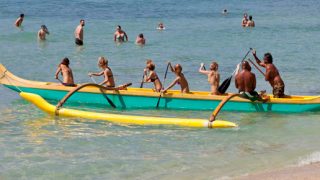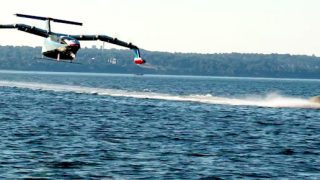Stand Up Paddle Boarding and Stand Up Paddle Surfing remain all the rage in Hawaii. And recently we’ve started seeing a new craze, often referred to as jet surfboards. Your editors Rob and Jeff are both avid long-distance swimmers and regularly swim 3500+ meters at Hanalei.
Motorized surfboards, sometimes called jet surfboards, are the latest disruptors in the personal watercraft area.
We saw two at Hanalei this past weekend. It’s summer here and no waves are needed! Surfing of course has ancient roots. What we’re seeing now, however, adds a high tech twist. If this is the first time you’ve heard about it, you aren’t much behind us. We just started seeing these appear in the past few months.
Re-enter electric surfboards.
Electric surfboards are not new. These are battery-powered and date back to about 1930 in Australia, when they were first referred to as surf scooters. They had a resurgence about forty years ago. But it is in the past 20 years, and now just this year, that they have regained traction and we are seeing them regularly here in Hawaii.
These puppies come in three basic forms, electric SUP’s, hydrofoil surfboards (what we’ve been seeing lately), which has a hydrofoil elevating rear, and lastly electric surfboards, which look like regular surfboards and are the fastest of the lot. There are also hand-held wing foils that help propel surfers even faster
Below is a video of Kauai’s Laird Hamilton foil boarding here.
Stand up surfing, also known as supping, became extremely popular among both locals and visitors.
Visitors can take the opportunity to try it during ideal calm conditions. It is highlighted again this week at the Annual Duke’s Oceanfest, a weeklong surfing celebration which takes place at Waikiki Beach, and is sponsored by the Outrigger Duke Kahanamoku Foundation. The event, which takes place in August each year, has been canceled for 2020.
Supping consists of standing on a modified long (9-11 foot) surfboard and using a canoe paddle as an oar. Boards with a soft surface are easier for learning. But while it may look easy, in reality, it is not, requiring good coordination. Therefore, it is most easily learned in calm, wind-free conditions. It is essential that you have appropriate swimming capabilities for supping.
Surfing has long played a role in Hawaiian culture. Once reserved exclusively for royalty, surfers would often travel from North to South shores to find the best year-round conditions. For more information, check out Stand Up Zone, a blog and forum dedicated to the sport.
The featured image in our post is of Duke Kahanamoku, which Google used to honor the 125th anniversary of his birth just five years ago. Surfing was immortalized by Olympic swimmer Duke in the 1920s. An iconic statue in his memory is found on Waikiki Beach.


Get Breaking Hawaii Travel News







Electric boards are heavy and very dangerous in the lineup – risk to other surfers. For that reason, they are illegal in many areas. I’m handicapped and would love to be able to have a device that would let me surf again, but I’m not about to put others at risk to do so. Now, if the user can find an isolated spot, fine – go for it – but we all know that most users aren’t like that. We’ve seen it with SUPs, and that’s why some SUP users have had very unhappy experiences with surfers.
Great article. With all of the looting and chaos on the mainland, it’s nice to see you guys are having some fun on Kauai!
Hi Curtis.
Thank you!
Aloha.
Looting and chaos? Can’t see any in Southern California. And last time I checked, we are on the mainland. Might as well select the nutcase who burned part of the neighborhood and killed two police officers in the area of Diamond Head, and talk about arson and chaos in the Islands. That wouldn’t be valid either. Do we sense an agenda?
Everyone gets wet when they learn to stand up paddle but it’s definitely more fun than hard. I always say, if you’re not falling down you’re not having enough fun. . . and that’s for beginners and experienced paddlers.
If you start out on the right equipment, even the big boys will be up and paddling with no problem on their first try. Before taking a lesson or renting a board, it’s a good idea to find out it they are using actual stand up paddle boards. It’ll make a huge difference.
Although big longboards and Softops might work for smaller paddlers, they’re definitely more tippy and will really be a struggle for most people. Find a school with the right equipment and you’ll have a blast on your very first try.
On Oahu, Hawaii there are several schools offering lessons. Here are just a few:
North Shore:
Rainbow Watersports
http://www.rainbowwatersports.com
Surf n Sea
http://www.surfnsea.com
East Side:
Hawaiian Watersports http://www.hawaiianwatersports.com
Wet Feet: http://www.wetfeet.com
Keys to success with SUP (learned the hard way).
1. Stability comes from the board having the maximum “footprint” on the water. This means, in real life, an egg shape with minimal nose rocker. And 32″ wide is about minimum. (Examples: Mirac, KM Hawaii). My 9’2″ x 32″ egg is more stable than my friend’s 10’6″ x30″.
2. So much of the instruction given is full of advice that isn’t really generically applicable. Just do it; you’ll figure it out. You don’t need the wide stance and exaggerated leaning over, etc. I didn’t start SUP until I was 75. I did it because I was having equilibrium issues and decided to do something that would force me to improve my balance. It worked.
3. Do some workouts at home for balance. Just standing on one foot in your living room is actually quite useful. If that’s too easy, do it with your eyes closed.
Thank YOU for this posting on paddle surfing.
Couldn’t agree with you more when you say “while it may look easy, in reality it is not, requiring good coordination”.
I had my first opportunity to try it and … well, I thought I had good coordination, but I really struggled.